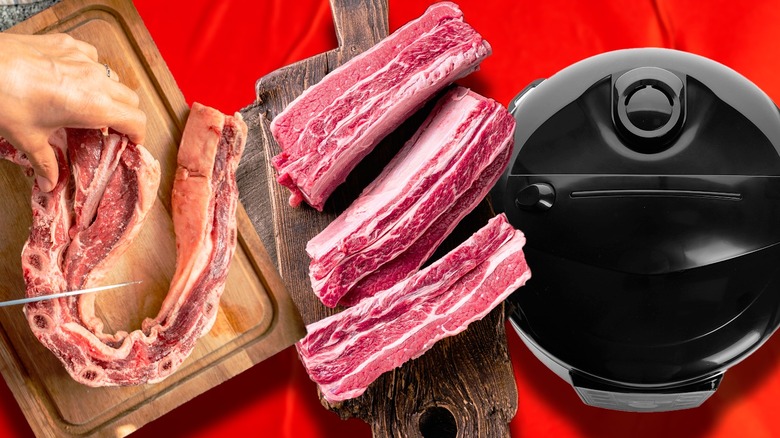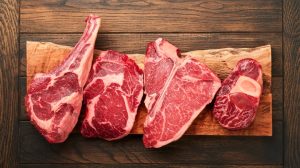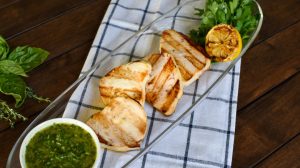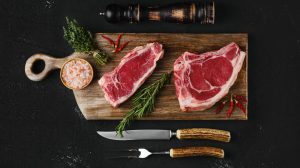Cuts of meat fall into two broad categories: tender cuts that cook quickly and tougher cuts that require long, slow cooking. That’s an oversimplification, but it’s a useful one. In the case of beef, grilling steaks like ribeyes and T-bones fall into the first category, while chuck roasts and short ribs are examples of the second.
Those tougher cuts can be rewarding — if you’re prepared to invest the time in them. The same characteristics that make them tough and chewy — dense muscle fibers, connective tissue, fat, and gristle — are what give them their rich flavors and textures once they’re fully cooked.
I’m a trained chef and former restaurateur, and I have a confession to make: Given a choice between a grilled steak and a plate of well-braised short ribs, I’m taking the ribs nine times out of ten. It’s not that I don’t like steak, you understand, but I love the rich beefiness of well-cooked short ribs. They’re a cut that rewards patience, but there are a few potential pitfalls lying in wait for the unwary or impatient cook.
Not learning the difference between short rib cuts
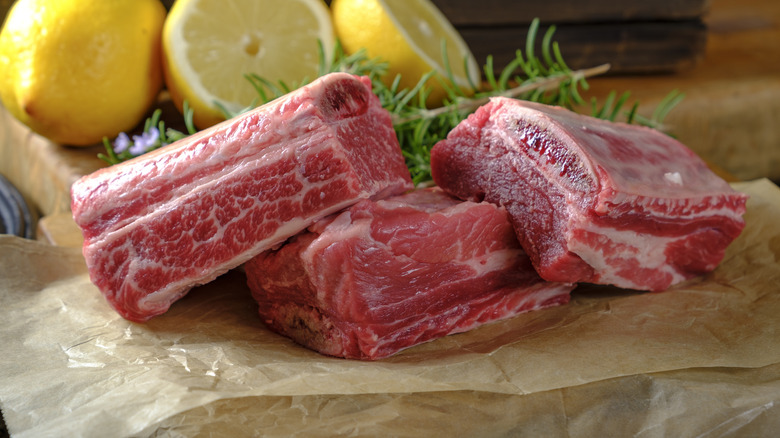
The short ribs you see at the store can come from three areas: chuck ribs are cut from the shoulder, back ribs are the same ones attached to your rib roasts and ribeyes, and “plate” short ribs come from the area where those back ribs extend down around the steer’s belly.
All three cuts of beef ribs are tough and need slow cooking, but there are differences between them. The back ribs usually have less meat on them because every ounce left on the bones is an ounce not sold at a premium as a rib roast or steak. Plate ribs are thick and meatier, like the meat of the neighboring brisket. Chuck ribs are the kind you’ll usually see in your grocer’s showcase, and like chuck roasts, they’re meaty and flavorful. Cooking methods for all three are similar, as long as they’re cut the same way, so the differences only really matter when a recipe specifies one or another.
A more pertinent detail is how they’re cut. You’ll often see short ribs in squared-off, almost cubical chunks cut from individual ribs, which may be described as “square cut” or “English cut.” Alternatively, you may see them cut into long, flat strips that incorporate pieces of several rib bones. Those are usually referred to as a “flanken” cut, though you may see them simply described as “short ribs for Korean BBQ” because that’s a popular use case for them.
Using the wrong cooking method for a given cut of short ribs
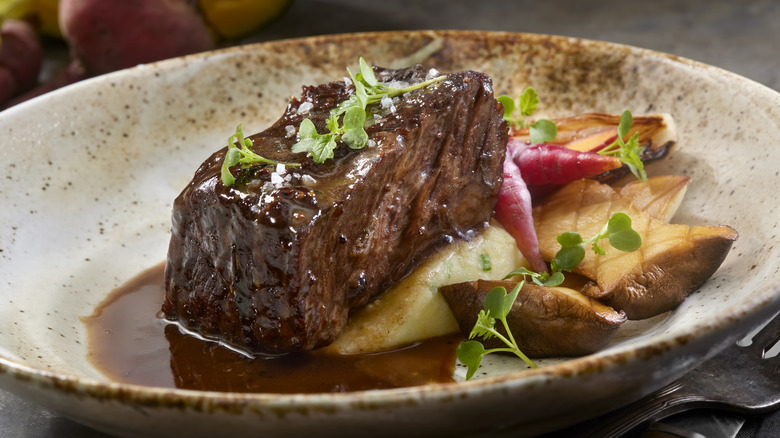
Most recipes for short ribs call for slow cooking, which is needed to break down the tough connective tissues in the ribs and turn them into rich, mouth-pleasing gelatin and collagen. The question is which cut your recipe calls for and how long it says to cook them.
Recipes meant for thick English-cut short ribs call for a relatively long cooking time, while those using thin flanken-cut short ribs need significantly less cooking. The two cuts of short ribs aren’t interchangeable in a given recipe, at least not without adjustments to your cooking time. English-cut ribs will be tough and undercooked in a recipe meant for flanken-cut ribs, while flanken-cut ribs will be overcooked and dry if used in a recipe meant for their thicker counterparts. If the recipe doesn’t specify which cut, look at the photo. If you see multiple bones in each portion, it’s flanken-cut. If you only see one bone per piece, then they’re English-cut.
There’s one more wrinkle, as well. Flanken-cut ribs, despite being a tough cut, can be very good when grilled like a steak, kalbi-fashion. Slicing the tough meat thinly gives it a pleasant chew, just as it does with flank steak or skirt steak. Even if you like your beef rare, grill flanken short ribs to a temperature of 170 F or so: It takes some heat to render their fat and break down the cartilage.
Overlooking the fat content of your ribs
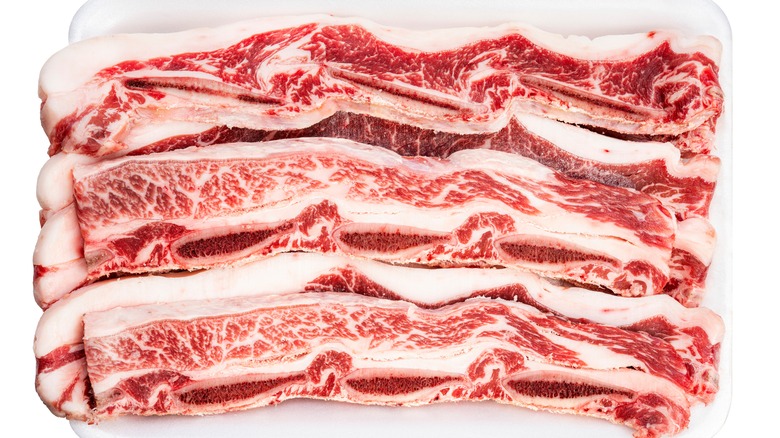
MERCURY studio/Shutterstock
Every cut of beef varies in the amount of fat it contains, even when you’re buying the same cuts from different animals. Beef is graded mostly by how much fat it contains, better known as “marbling.” The technical term for it is intramuscular fat, meaning fat that’s incorporated throughout the muscle tissues, rather than intermuscular fat, which is outside or between separate muscles.
With short ribs, what you’ll see is often muscle layered with bands of intermuscular fat. It’s important to understand that a certain amount of fat is part of what makes short ribs so rich and wonderful, just as it is with racks of pork ribs. But it can also be too much of a good thing, and the individual variation from one animal to the next means you can see a pretty large difference between one package of ribs and another.
Taking the time to compare is one of Ina Garten’s best tips for short ribs. It’s easier with flanken cuts because, like steak, you’ll be able to see how much internal marbling they contain versus how much fat comes from the layers between. With English-cut short ribs, it’s harder to gauge their internal marbling, but you can still look at the layers of meat and fat side-on and choose packages where the ratio of meat to fat is higher.
Skimping on the liquid in your braise
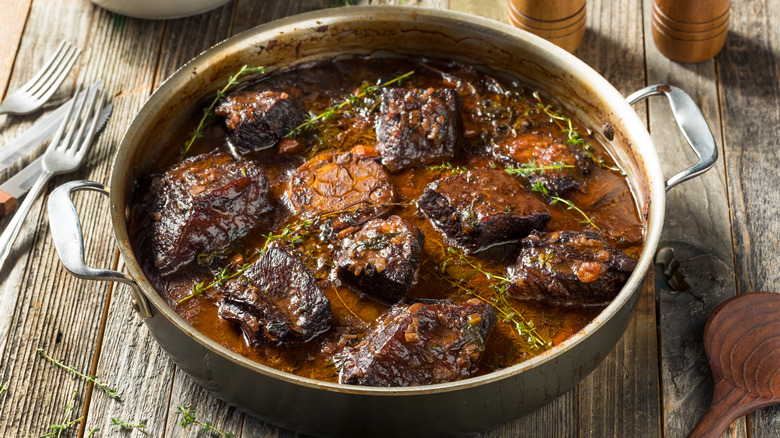
Brent Hofacker/Shutterstock
Theoretically, braising is one of the easiest cooking methods there is. You pour in plenty of liquid with the meat, pop it into a low oven (or your slow cooker), and then you walk away for several hours as your house fills with rich, appetizing aromas.
In practice, as with most other cooking methods, there are still some things you can get wrong. One of the most important is not using enough liquid for your braise. Ideally, no more than ¼ to ⅓ of the ribs’ thickness should show above the liquid when you start cooking, though with a large cut, the liquid can come as little as halfway up the side and still be enough. This can take more broth or other liquid than you think, depending on the size and shape of your dish: Celebrity chef Geoffrey Zakarian braises his short ribs with a whole bottle of red wine, for example.
It’s important because the part of the ribs immersed will cook more quickly than the part that’s exposed; you might even want to stir or turn your ribs occasionally. Evaporation is another factor to consider. Some recipes call for your ribs to braise uncovered, leaving parts of your ribs exposed and undercooked. Others suggest covering the meat with a lid, foil, or a sheet of parchment paper that’s cut to fit to keep the braising liquid from evaporating too quickly.
Not searing your short ribs before braising them
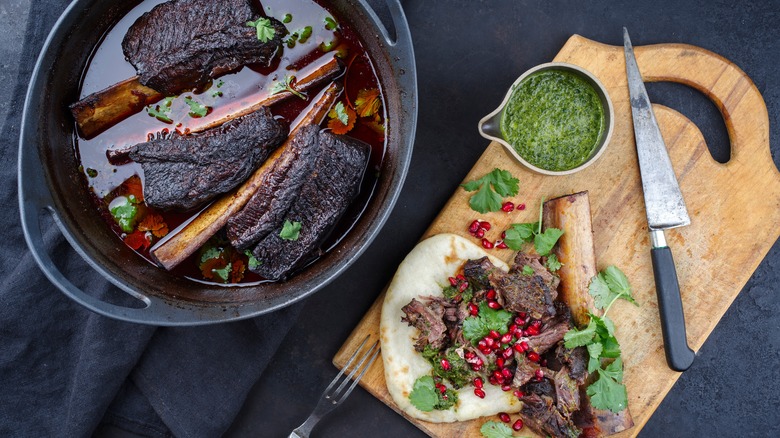
hlphoto/Shutterstock
Part of the appeal of braising is that while it takes a long time, it’s mostly hands-off time. You can pop your short ribs into the oven or a slow cooker and then get on with your day for several hours while they look after themselves. No fuss, no muss, no bother.
But there’s an essential step you should always take before putting your meat in the slow cooker or oven, and that’s searing the ribs. Yes, it adds some time to the process, and it can leave fat spatters on your stove and fill your kitchen with greasy smoke, but it’s still worth it. Why? Because browning adds a ton of flavor to the beef, thanks to chemical reactions (the Maillard reactions) that transform the meat’s natural sugars and amino acids into new, complex aroma and flavor molecules. Try it yourself: Cut a piece of beef in half and poach one half, but grill the other. There’s no comparison.
These new flavors will enrich the taste of the ribs themselves, and some will also seep into the braising liquid as the ribs cook. Ideally, you’d do the searing part in the same Dutch oven you’ll later braise in, so any browned-on juices will automatically find their way into the finished meal. If not, use part of your braising liquid to deglaze the pan you used for searing, and then pour the mixture into your pot or slow cooker.
Bringing your short ribs to a boil
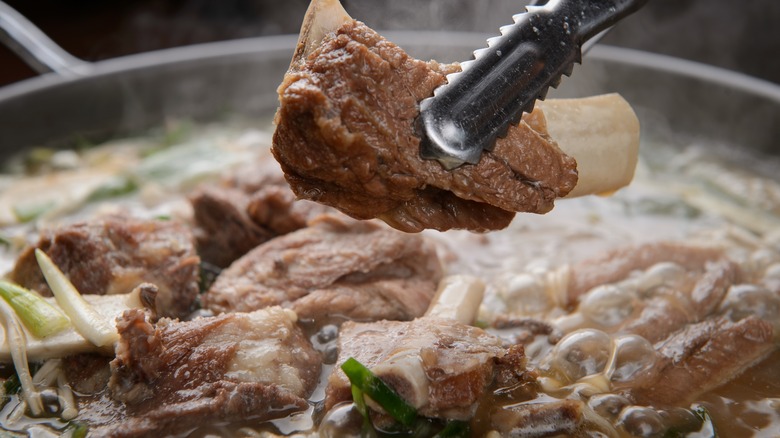
photohwan/Shutterstock
Braising is essentially a form of oven-poaching. You’re simmering the short ribs tenderly in hot liquid, raising their internal temperature slowly until their dense muscle fibers relax and soften and their connective tissue melts.
You might think that higher heat can make that happen more quickly, but letting your ribs come to a boil is actually counter-productive. At that temperature, the muscle fibers in the ribs — which, you’ll recall, are already dense and tough — contract and tighten, making them even denser and tougher. If you’ve ever had braised beef come out chewy instead of lush and tender, that’s one likely explanation (another is that you just didn’t cook them long enough).
Once they’ve contracted and tightened, it will take a while for the muscle fibers to relax again. Not only won’t you save any time by bringing them to a boil (or letting them come to a boil accidentally), you may end up needing to give them more cooking time overall.
Using the wrong wood for smoking them
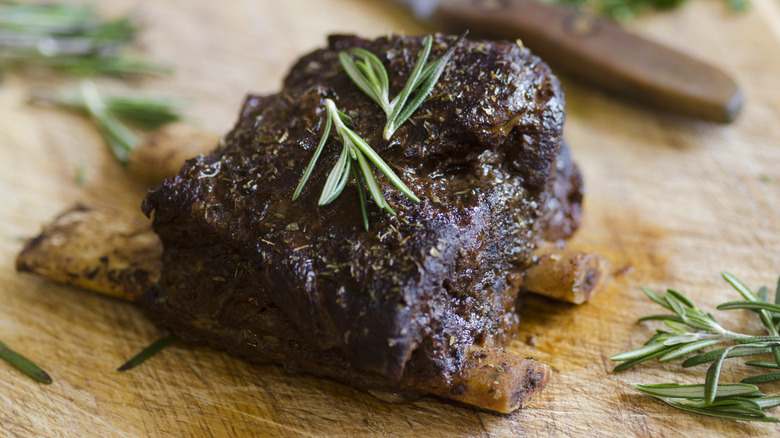
Martinturzak/Getty Images
While braising is arguably the canonical method for cooking short ribs, they also work great as barbecue. In the Korean sense of the word, that means grilling a thin flanken cut, but short ribs (especially from the plate) also excel in the form of traditional, slow-smoked barbecue.
If you want to get a good debate going among barbecue enthusiasts, one of the quickest ways is to get them started on the subject of which woods are best for smoking a given meat. Often, bold-flavored woods like hickory, oak, or mesquite are suggested for beef, but for many of us, that’s a misstep.
Yes, beef can technically stand up to those strongly-flavored hardwoods, but they’re best used with quicker-cooking cuts like steaks. For slow-cooking short ribs, which will spend a lot of time in the smoker, you may find that you’re better off adding extra flavor to short ribs using fruitwoods such as apple, cherry, or peach. Their flavors are lighter and more nuanced, and they won’t overpower the short ribs’ signature beefiness.
Missing the chance to load your braising liquid with flavor
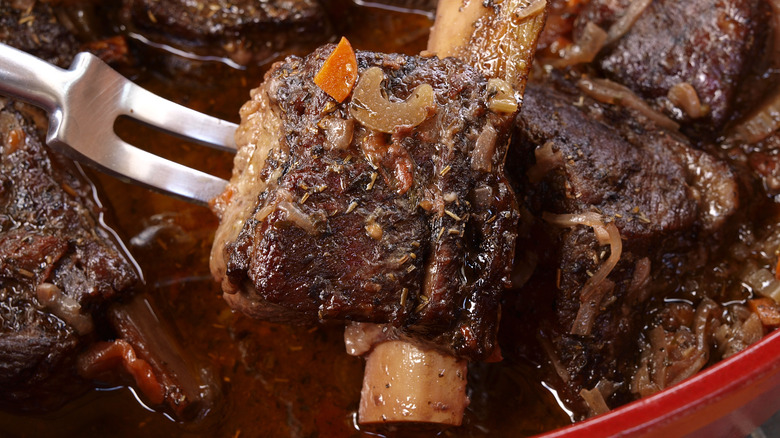
Cislander/Getty Images
What do you use as the braising liquid with your short ribs? A lot of cooks start with just water and maybe some salt and pepper, and that’s fine. Short ribs have plenty of flavor, and they can cope. But you’re missing a bet if you don’t load up your braising liquid with flavors.
An obvious starting point is your choice of liquids. Water will do, but beef broth is better — if you don’t have any, you can just add a spoonful of Better Than Bouillon or something similar. Red wine is another surefire choice, though don’t overlook beer as an option. Beef simmered in beer is a Belgian classic, and while it’s different from braising in wine, it’s every bit as good. Most chefs will advise you the best type of beer for braising short ribs is lightly hopped beers, like lagers, because that heavily hopped artisanal IPA you love will turn bitter as it cooks.
Aside from the liquid itself, your fridge and spice rack offer plenty of other ways to add flavors to the mix. Onions, garlic, celery, carrots, and mushrooms in any combination provide a sturdy set of base flavors. Tomatoes pack a tart and savory punch with acidity to help tenderize the short ribs. Bay leaves, rosemary, thyme, and oregano all work well. So do spices ranging from chili peppers to juniper berries, coriander, cumin, and even typically “warm” spices like cinnamon or cloves.
Not reducing your braising liquid to make a sauce
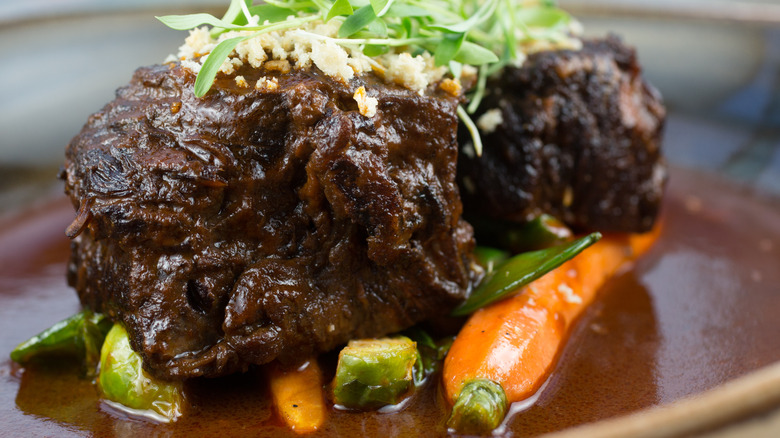
Lisa Wiltse/Getty Images
When you pull your short ribs from the oven or slow cooker, what do you do with the braising liquid? It’s packed full of flavor, so most recipes assume that you’ll turn it into a sauce to serve with the finished dish.
The question is how you choose to get there. The easy and familiar option is thickening the braising liquid with flour or cornstarch, just as you would if you were making gravy from a pot roast. This has the advantage of yielding the maximum amount of sauce, but if you’ve used too much liquid in your braise, it may not give you the best flavor.
A better option, the traditional method favored by chefs and old-school home cooks, is simply to simmer the braising liquid until it loses its excess water content through evaporation. This is called a “reduction” because the cooking-down process gives you a reduced volume of sauce, but the flavors become seriously concentrated. It usually won’t need a starch-based thickener (good news for the keto enthusiast in the crowd) because the short ribs’ dissolved connective tissues from cooking added a natural thickening power to the juices. To check when it’s reduced enough, drag the back of a spoon through the sauce. If it coats the spoon and dragging a fingertip through the sauce leaves a mark that lingers, it’s done.
Missing out on alternative cooking methods
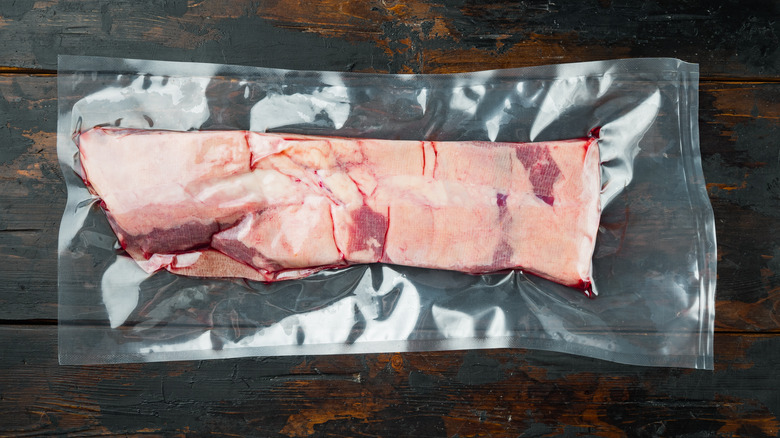
Chatham172/Shutterstock
Short ribs work well in the smoker, and flanken-cut ribs grill beautifully, but if one cooking method could be described as all-encompassing, it has to be braising. It’s a slam-dunk with short ribs, but a couple of newer alternative cooking methods are also worth your attention.
One is the use of a pressure cooker with your short ribs, whether you have a classic stovetop model or one of the newer electric versions. Pressure cookers provide a way to arrive at the meltingly soft texture of braised or slow-cooker ribs in a fraction of the time, turning them into something you can decide to cook relatively late in the day. Some cooks (including me) consider short ribs to be one of the best uses of their Instant Pot.
Another recent high-tech cooking method that’s great for short ribs is sous vide cookery. This calls for sealing the short ribs and any flavoring ingredients in a vacuum bag and then cooking them at a precise temperature (for a long time) with a sous vide circulator. With this method, you can either replicate the texture of braising or tenderize the tough ribs to a steak-like texture, depending on the time and temperature you choose. Either way, short ribs are one of the best cuts for sous vide cooking.
Failing to make plans for your leftover short ribs
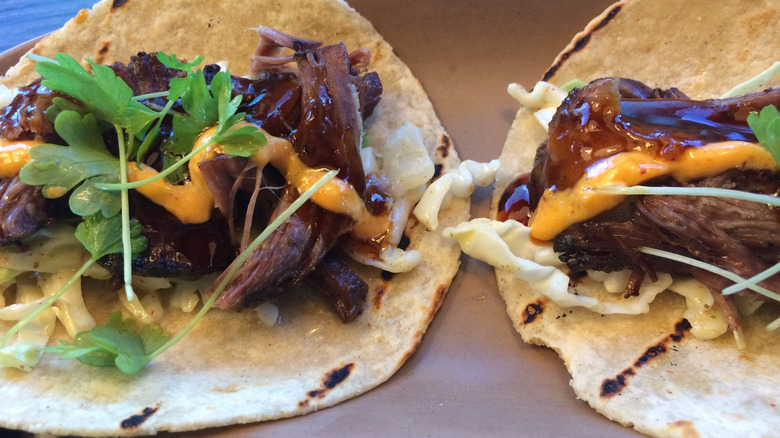
Juli V/Shutterstock
With something as tasty as short ribs, leftovers might not be the first thing on your mind — and I have to confess, they tend not to last long in my house either. Still, if you get a good deal on them, it’s well worth your time to make more than you’ll eat in one sitting.
As with pot roast, leftover short ribs can be shredded easily for use as a high-impact ingredient in other meals. They’re excellent in tomato sauce as a replacement for ground beef, for example. In fact, braising your short ribs in tomato sauce is a classic go-to for making an old-school ragu — some may know it as “Sunday gravy.”
Shredded short ribs can make an instant upgrade for almost any other recipe that calls for beef, as well. Chopped finely and mixed with a bit of leftover sauce or braising liquid, they’ll make a memorable filling for ravioli or other dumplings. With the right spices and garnishes, short ribs can make some of the best tacos you’ve ever had. They’ll work just as well in casseroles, pot pies, burritos, or even something as simple as a hash to go with your fried eggs at brunch. Let your imagination run wild because it’s pretty hard to go wrong with short ribs.



